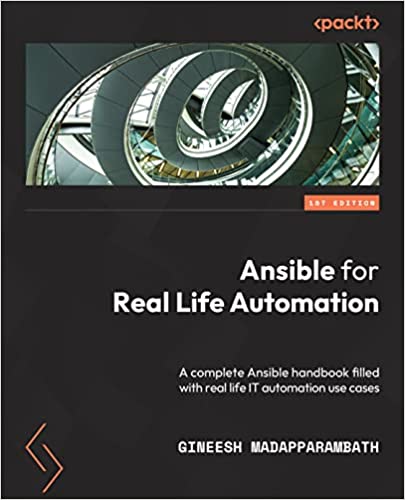Q: What are your specialist tech areas?
Gineesh: Ansible automation, Kubernetes, OpenShift, Terraform
Q: How did you become an author for Packt? Tell us about your journey. What was your motivation for writing this book?
Gineesh: I write a lot of articles and blogs (techbeatly.com, https://www.redhat.com/sysadmin/user/446371 etc) and I had a plan to collectively publish articles on Ansible Automation use cases. The initial plan was to publish it as an e-Book and share it via the website. But few of my friends asked me (pushed me actually) to try something like a real book. So I checked with Packt and decided to publish this book.
Members of the community used to ask repeated questions and that is the reason I started publishing blogs. I believe, that writing a book on those topics will help the learning community to follow a track and understand better what they are learning.
Q: What kind of research did you do, and how long did you spend researching before beginning the book?
Gineesh: I am working in the same technology for quite a long time but I still did a lot of research for the content to make sure the content is effective and meaningful for the learning community to use in their learning process. It took about 3 months to plan the entire content.
Q: Did you face any challenges during the writing process? How did you overcome them?
Gineesh: Yes, in terms of finding free time to prepare the labs, writing content and so on. Technically, it was a great experience as I also learn a lot during the writing process.
Q: What’s your take on the technologies discussed in the book? Where do you see these technologies heading in the future?
Gineesh: Ansible is the #1 open-source automation software available right now and it is very flexible to support every component in the IT and application infrastructure. Ansible community is growing rapidly and the contribution from various communities, vendors and individuals make the product and platform stronger and more powerful.
Q: Why should readers choose this book over others already on the market? How would you differentiate your book from its competition?
Gineesh: This book focuses on real-life automation use cases rather than teaching Ansible and its features. I have focused on most general IT automation use cases so that the learners can relate them to their work environment, understand the use cases and implement it on their own.
Q: What are the key takeaways you want readers to come away with from the book?
Gineesh:
1. Learn the basics of Ansible.
2. Practice with simple use cases and slowly make enhancements.
3. Break the large workflows into small use cases and implement them.
4. Join and ask in the community.
Q. Do you have a blog that readers can follow?
Gineesh:
1. techbeatly.com
2. https://www.redhat.com/sysadmin/user/446371
3. iamgini.com
Q. Can you share any blogs, websites and forums to help readers gain a holistic view of the tech they are learning?
Gineesh:
1. Blog: techbeatly.com
2. Active community: https://t.me/techbeatly (telegram)
3. Learning materials, updates: https://www.linkedin.com/company/techbeatly
Q. How would you describe your author’s journey with Packt? Would you recommend Packt to aspiring authors?
Gineesh: It was amazing; everyone helped me and guided me during the entire process.
indeed I will (I have already)
Q. Do you belong to any tech community groups?
Gineesh:
1. https://www.linkedin.com/company/techbeatly
2. https://www.meetup.com/ansible-singapore/
3. https://t.me/techbeatly (Active chat group)
4. https://www.linkedin.com/company/devopsmalayalam
5. https://www.meetup.com/cloud-native-development-with-openshift/
Q. What are your favorite tech journals? How do you keep yourself up to date on tech?
Gineesh: I read most of the tech blogs and websites regularly. When I notice a piece of new information or technology, I will add it to my personal tracker (Trello) and find time to work on it and understand it. If there is a missing part of the documentation, I keep my own version (1. techbeatly.com
2. https://iamgini.com)
I am a doer person and I always do hands-on on the topics and technologies in which I have an interest.
Q. How did you organize, plan, and prioritize your work and write the book?
Gineesh: I have used Trello and Google Sheets primarily for tracking the chapters, tasks, remarks and so on. Trello helped me with tracking the pending items and I was able to see the due items from my calendar itself.
Q. What is the one writing tip that you found most crucial and would like to share with aspiring authors?
Gineesh: Think like a reader when we write the content and assume they are reading this book because they are looking for information from our book.
You can find Gineesh’s book on Amazon by following this link: Please click here









